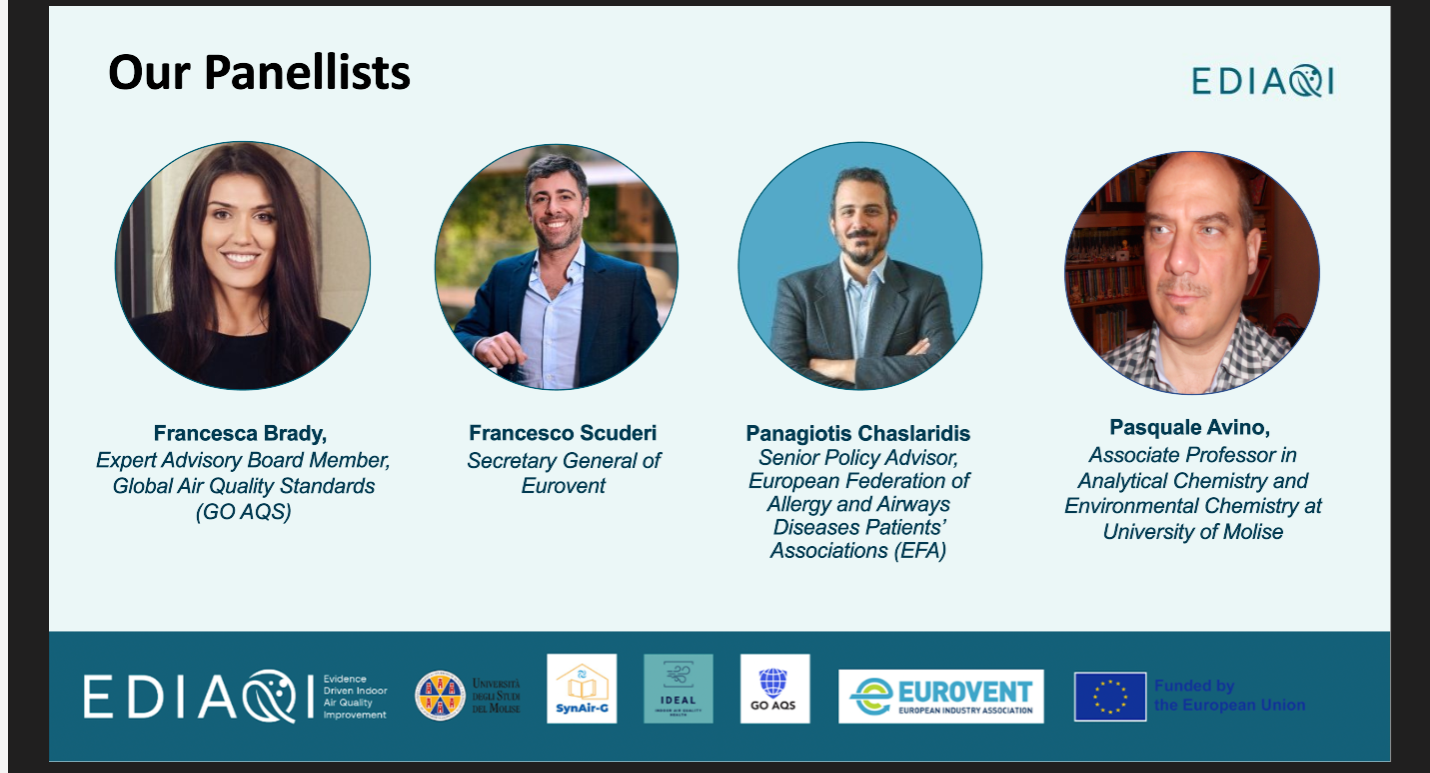
Europeans spend 90% of their time indoors, yet Indoor Air Quality (IAQ) remains largely overlooked in policy frameworks. The “Mind the Gap: Toward a Comprehensive European Union Act on Indoor Air Quality” webinar, co-organised by the SynAir-G and EDIAQI projects, brought together leading experts to discuss how science, policy, and industry can work together to create an EU-wide IAQ framework.
A Fragmented Policy Landscape
Francesca Brady (GO AQS) highlighted the lack of cohesion in IAQ regulation, contrasting it with the more structured approach to outdoor air quality. She called for open-access regulatory guidelines, allowing policymakers, industry, and researchers to collaborate more effectively in accelerating IAQ policy implementation. She also stressed the importance of equity in IAQ legislation, ensuring vulnerable populations—such as low-income tenants—are better protected.
Industry’s Role in IAQ Policy
Francesco Scuderi (Eurovent) demonstrated how industry collaboration with policymakers has been instrumental in revising the Energy Performance of Buildings Directive (EPBD). He emphasized that beyond lobbying efforts, public education on IAQ is key to ensuring broad support for stricter air quality regulations.
From Science to Policy: Overcoming Fragmentation
Panagiotis-Minos Chaslaridis (EFA, IDEAL Cluster) described the puzzling policy fragmentation surrounding IAQ. While IAQ regulations exist, they are scattered across various sectoral policies—with notably little recognition in health policy. He stressed the need to translate scientific research into actionable policies, addressing both technical and political barriers.
One major roadblock? The perception that IAQ is solely a national competence. Chaslaridis argued that, given the health burden of poor IAQ, it should be recognized as a public health issue requiring an EU-wide response. He advocated for a clear EU definition of IAQ, an essential first step toward a harmonized regulatory framework.
The Role of Research and Academia
Dr. Pasquale Avino (University of Molise, EDIAQI) reinforced the critical role of academia in developing IAQ measurement methods and guidelines. However, he emphasized that one of the biggest challenges is changing public perception—for too long, outdoor pollution has been seen as the primary concern, despite the fact that we spend most of our time indoors.
Academia can also facilitate stronger collaboration between researchers, policymakers, and industry to ensure that scientific advancements lead to practical IAQ solutions.
Prioritizing Vulnerable Groups
Both Brady and Chaslaridis stressed that IAQ policies must consider the needs of vulnerable populations—including low-income communities, children, and those with respiratory conditions. Chaslaridis highlighted the importance of involving these communities directly in policymaking, as their first hand experiences provide crucial insights into the human impact of poor IAQ.
Brady pointed to the EU Green Deal and Renovation Wave Strategy as potential frameworks to integrate IAQ measures. However, public awareness remains a significant challenge—GO AQS is working to bridge this gap by promoting science-based evidence and fostering public-private partnerships to drive research and policy.
The webinar reinforced the urgent need for an EU-wide IAQ framework that integrates science, policy, and industry collaboration. With momentum building, stakeholders must now push for a common definition, minimum standards, and stronger public engagement to ensure that clean indoor air is a right for all.
